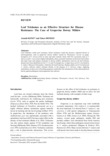Leaf Trichomes as an Effective Structure for Disease Resistance: The Case of Grapevine Downy Mildew
| ISSN | 00213551 |
|---|---|
| NII recode ID (NCID) | AA0068709X |

Leaf trichomes confer pest resistance. Dense trichomes could also present a physical barrier to microorganisms, such as grapevine downy mildew caused by Plasmopara viticola on grape. Zoospores of P. viticola swim in water and enter stomata. Some wild Vitis accessions such as V. labrusca and V. cinerea have highly hydrophobic, dense, prostrate trichomes on the lower leaf surface that repel water and enhance resistance to downy mildew. Quantitative trait loci for leaf trichome density have been identified on LGs 5, 7, 8, and 15 of grapevine. A major locus on LG 5 was found in V. vinifera ‘Muscat of Alexandria’, which has few leaf trichomes. Hairless alleles on LG 5 in historical V. vinifera cultivars reduce trichome density in the progeny of V. labrusca origin. Applying information on these loci in breeding programs would allow the introduction of this natural physical barrier against pathogenic microorganisms into cultivars.
| Date of issued | |
|---|---|
| Creator | Atsushi KONO Takeo SHIMIZU |
| Subject |
preexisting disease resistance Plasmopara viticola Vitis labrusca Vitis vinifera |
| Publisher | Japan International Research Center for Agricultural Sciences |
| Received Date | 2019-12-17 |
| Accepted Date | 2020-03-05 |
| Available Online | |
| Volume | 54 |
| Issue | 4 |
| spage | 293 |
| epage | 298 |
| DOI | 10.6090/jarq.54.293 |
| Language | eng |
